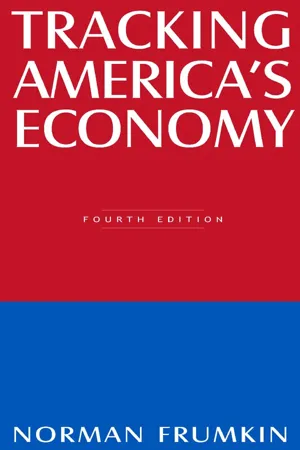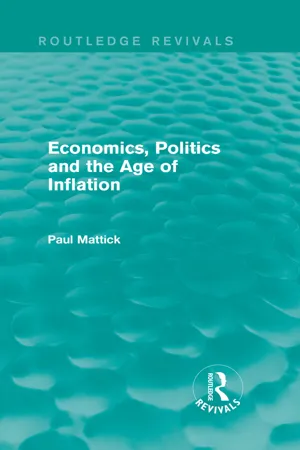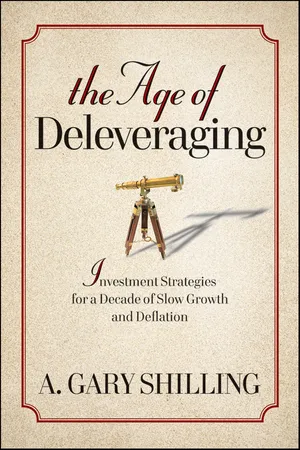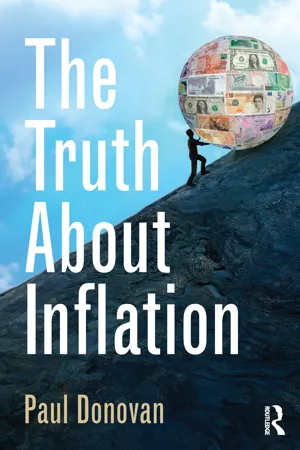Economics
Inflation and Deflation
Inflation refers to the general increase in prices of goods and services over time, leading to a decrease in the purchasing power of money. Deflation, on the other hand, is the general decrease in prices of goods and services, often resulting in reduced consumer spending and economic activity. Both inflation and deflation have significant impacts on an economy's stability and growth.
Written by Perlego with AI-assistance
Related key terms
8 Key excerpts on "Inflation and Deflation"
- eBook - ePub
- Norman Frumkin(Author)
- 2015(Publication Date)
- Routledge(Publisher)
11Inflation and Deflation
Prices influence and reflect many aspects of the private and government sectors of the economy. They are both a driving force and a culmination of the various elements of demand and supply in the marketplace. Different geographic, industrial, financial, real estate, and labor markets vary considerably in their competitive and monopolistic features, and prices are the summation of the varying degrees of market imperfections. Prices are also affected by extra-market considerations, such as war or threat of war, the environment, and natural disasters (e.g., drought, floods, earthquakes, tornadoes).Prices of goods and services vary considerably among individual items bought and sold in the marketplace. There is the intrinsic difference in the absolute price of one item in comparison to another at a point in time, such as the price of a car and of college tuition. There are continuing differences in the movements of prices over time, such as price changes of a car and of college tuition from one year to the next. Some items rise in price more than others, some decline in price more than others, and some are unchanged from one period to the next. These differential price movements reflect actual or perceived shortages or surpluses among buyers and sellers and varying degrees of price competition for particular items. Changes in overall price levels for the total of all goods and services are the net effect of the varying upward, downward, and stable movements of the vast number of items sold in markets around the United States.There are also varying degrees of inflation (price increases) and deflation (price decreases) that have differential effects on the economy. In general, overall price movements affect the economic well-being of the population in the following way: people are better off if their incomes increase more than prices increase, or if their incomes fall less than prices fall. - eBook - ePub
The Macroeconomic Environment of Business
Core Concepts and Curious Connections
- Maurice D Levi(Author)
- 2014(Publication Date)
- WSPC(Publisher)
Figure 4.1 which describes U.S. inflation history over almost a century—shows that inflation—a rising price level—is far more frequent than deflation—a declining price level—although there have been occasions, such as during the Great Depression, 1929–1933, when prices fell sharply.Fig.4.1. Almost a century of U.S. Inflation and Deflation.Source: United States Bureau of Labor http://en.wikipedia.org/wiki/File:US_Historical_ Inflation.svg .Inflation rates can differ greatly between countries and within countries over time.In this chapter we explain possible causes of inflation. We also consider the effects of inflation and the importance of how accurately inflation is forecasted by savers, workers and others. As we shall see in later chapters, unanticipated inflation is in many ways more important than the rate of inflation itself, having an important bearing on other macroeconomic phenomena, including unemployment, GDP and interest rates. This is why we set out to deal with as many aspects of inflation as we can, all in one chapter; later chapters can then build on these foundations. However, before dealing with the causes and effects of inflation it is useful to consider how it is measured, and the accuracy of the alternative measures that are used. We shall see that as with most important macroeconomic variables, published inflation statistics are only estimates, requiring some care in interpretation.1MEASURING INFLATIONAs we are all well aware, inflation reduces the buying power of any given dollar amount of income or savings. The rate of inflation is measured by the rate at which an index of prices goes up (or goes down in the case of deflation). The price index - Imad A Moosa(Author)
- 2013(Publication Date)
- WSPC(Publisher)
Chapter 1INFLATION, DEFLATION, DISINFLATION AND ALL THAT1.1.What is Inflation?It is often said that inflation is inevitable, like death and taxes. This is probably because, as Sir Frederick Keith-Ross mentions, “inflation is like sin; every government denounces it and every government practices it” (Makochekanwa, 2007). Historical stories about inflationary episodes proves that it is a phenomenon that has existed ever since money was used as a medium of exchange. Inflation is a topic that receives significant attention in the media, with regular features, reports and interviews. It is an issue that is often debated by politicians in Parliament and election campaigns, let alone economists and business executives.The reason why inflation is treated with “respect” is that it affects everybody in various ways. It is an important consideration during mortgage payments and in determining the cost of essential goods and services required for survival and those that make our lives more pleasant. We anticipate news about whether the central bank will decide to cut or raise interest rates, with inflation typically being the prime consideration (at least for some central banks). Most of us are fascinated by documentaries on the great inflation in Germany during the 1920s and how it relates to the rise of Adolf Hitler. Inflation has broad implications for the state of the economy and whether or not we can keep our jobs or find new ones. While it is regarded as one of the four macroeconomic variables closely monitored by policymakers (the others being growth, employment and the balance of payments), it is often the prime indicator that triggers drastic policy actions. “Inflation targeting” is a more common concept than “output targeting”, “employment targeting” or “balance of payments targeting”.Inflation is defined in different ways, but, in general, the phenomenon is about rising prices of goods and services (hence, the cost of living). As the prices of goods and services rise, the value (or purchasing power) of money falls in the sense that a monetary unit (say a dollar) buys less and less goods and services resulting in a diminishing basket. This is why inflation is viewed as a “persistent” erosion of the value of the money. While it cost 60 pounds to purchase a first class ticket on the Titanic in 1912, there is no way these days that this amount can buy a ticket to cross the Atlantic (let alone the Pacific) in a first class cabin on an ocean liner (perhaps 10,000 pounds can do the job). It is for this reason that we give our children more pocket money than what our parents gave us. People are typically nostalgic to the “good old days” when things were very cheap — the culprit being inflation.- eBook - ePub
- Krish Bhaskar, David F. Murray(Authors)
- 2015(Publication Date)
- Routledge(Publisher)
2 inflation caused by deficit financing may not necessarily be removed by creating a balanced budget.Instead we shall use a definition which falls into the first category. Inflation we shall define as ‘a sustained upward trend in the general level of prices’. By implication it may be difficult to detect whether, at any given time, there is an upward trend in prices and whether this trend is sustained. In any case, not all price rises are truly inflationary; they may reflect the normal short term workings of the market place or improvements in product quality. The construction of price indices to show changes in the general level of prices is difficult not only for these reasons but also because of the need to attach weights to the commodities included in the index reflecting their relative importance which may, in any case, be continuously changing over time.There are two further problems which we must mention here. Inflation is generally considered to be undesirable yet an annual increase in the general level of prices of, say, 1.5 per cent may be argued by some economists to be beneficial in stimulating economic growth whereas they would join the consensus of opinion against a 25 per cent per annum rise. The problem of deciding when the rate of increase in prices becomes unacceptable therefore remains. Secondly, a distinction is often made between price inflation which refers to the rate of increase of prices and wage inflation which refers to the rate of increase of money wages. Inflation is normally measured by the rate of increase of prices, although clearly wages and prices are closely related. - eBook - ePub
The Coming Bond Market Collapse
How to Survive the Demise of the U.S. Debt Market
- Michael G. Pento(Author)
- 2013(Publication Date)
- Wiley(Publisher)
stable means not easily moved. However, to the men and women who control our money supply, it means increasing about 2 percent a year. So determined are they that the economy not be met by the evil deflationary monster that they create inflation of 2 percent (as measured by the phoniest of inflation measurements known as the Personal Consumption Expenditure Price Index). This is done as a buffer or wall to block evil deflation from coming in—because once that evil deflation monster enters the economy, they fear he will never leave.The word deflation is a little nebulous in that it is used by economists in a technical way to describe a decline in the money supply. Most laypeople view deflation as a generalized decline in prices. Inflation , in turn, would refer to an increase in prices or, more technically speaking, an increase in the money supply or the fear of such a future increase in its supply that causes a decline in the purchasing power of the currency.As a follow-up to my introduction on decreasing prices, I have decided to start my critique of Fed myths with the Keynesian Fed-lore of the “deflationary death spiral”; this Fed-lore is very widely held and promulgated. The men and women at the Federal Reserve believe that a slight increase in prices is a sign of a growing economy and falling prices are devastating.Let’s put this Keynesian Fed-lore to the test and see how it holds up.In an economic environment of increasing productivity accompanied by a static money supply, one would assume that prices would slightly decrease. As an industry becomes more productive and makes better use of technology, those technological advances aid in the reduction of costs associated with producing the product. Profit margins improve, and in a competitive environment, businesses will pass most of these savings on to consumers. So with truly stable prices, the costs of many items would go down, and that would be a positive result; it would indicate that businesses were leveraging productivity to increase profit margins and decreasing the price of goods to consumers. However, outside of technology, we rarely see this materialize.Those at the Fed view any deflation as harmful, regardless of the cause. Ben Bernanke has said that “deflation is in almost all cases a side effect of a collapse in aggregate demand—a drop in spending so severe that producers must cut prices on an ongoing basis in order to find buyers.”1 - eBook - ePub
- Paul Mattick(Author)
- 2017(Publication Date)
- Routledge(Publisher)
2 Deflationary InflationIt is popular nowadays to distinguish between the inflation of time past and a new kind of inflation, which accordingly requires a new explanation, although in its monetary aspects inflation has the same features now as before: rising prices or the diminishing buying power of money. While its opposite, deflation, was viewed as contracted demand resulting in falling prices, inflation was explained by insufficient supply, driving prices up. Since, however, in this view it is the commodity market that determines price formation, little attention was paid to monetary policy. Money was seen merely as a veil concealing real processes, obfuscating them but altering little in their essential nature.This theory was also accompanied by the illusion, still lingering today, that the quantity of money in circulation in the economy has an important influence on commodity prices and that price stability depends on an equilibrium between the quantity of money and the total volume of goods. The modern advocates of the quantity theory of money also attribute deflation and inflation to a too slow or too rapid growth in the supply of money, and as a remedy to these anomalies they propose the creation of money adjusted proportionally to actual economic growth.Thus in money theory the economic cycle is represented as an expansion and contraction of the money supply and of credit not commensurate with the real situation. But it was expected that the equilibrium mechanism of the market would ultimately steer things back to normal. The crisis of the thirties, however, which seemed to have taken hold for good, put an end once and for all to any notions of such an automatic self-establishing equilibrium. In Keynes's view, which dominated bourgeois economic theory in the years that followed, the laws of the market were no longer capable of bringing about economic equilibrium with full employment. A developed capitalist economy, claimed Keynes, made for a decline in effective demand and with it a fall-off in investments and growing unemployment. Although this theory was designed specifically to explain economic stagnation during the period between the two world wars, it was quickly given universal status and regarded as the last word in the science of economics; to avoid the deflationary state of the depression and to restore economic equilibrium with full employment, state measures were needed to stimulate overall demand. - eBook - ePub
The Age of Deleveraging
Investment Strategies for a Decade of Slow Growth and Deflation
- A. Gary Shilling(Author)
- 2010(Publication Date)
- Wiley(Publisher)
Figure 8.2 ).In any event, when the nation is not at war—a shooting war, a cold war, or the War on Terror—deflation is the norm as government spending in relation to gross domestic product (GDP) drops back. During those times, the productive capability of the nation, and now the world with globalization, is so great that supply chronically exceeds demand. That's what I believe lies ahead, assuming that the War on Terror will be wound down and not escalate into Cold War dimensions. That implies that deflation will reign until the next major war or some similar event. And unfortunately, unless human nature suddenly changes, there's another war out there in future years, waiting for us in the underbrush.Seven Varieties of Inflation/DeflationWhen we talk about inflation or deflation, we usually mean what is measured by the CPI, producer price index (PPI), GDP deflator, or other measures of aggregate price movements. I've identified, however, seven varieties of inflation/deflation that need to be kept in mind:Commodity Inflation/Deflation1. Commodity2. Wage-price3. Financial asset4. Tangible asset5. Currency6. Inflation by fiat7. Goods and servicesIn the late 1960s, the mushrooming costs of the Vietnam War and the Great Society programs in an already-robust economy created a tremendous gap between supply and demand in many areas. The history of low inflation rates for goods and services (we'll call it CPI inflation for short) in the late 1950s and early 1960s apparently created a momentum of low-price advances that held CPI inflation in check until about 1973 (Figure 1.5 ). But by the early 1970s, commodity prices started to leap (see Figure 8.3 - eBook - ePub
- Paul Donovan(Author)
- 2015(Publication Date)
- Routledge(Publisher)
As was hopefully made clear from the outset, the aim of this book has been to explain inflation and not to predict inflation. There is no point an economist trying to publish a book that offers predictions on the future course of inflation for a global audience – it would be out of date before it reached the bookshelf or the e-book reader. Inflation is going to vary from country to country. Inflation is going to vary from age group to age group. Inflation is going to vary from income group to income group. Inflation is one thing for a company, another for a consumer, and something else entirely for a borrower. Inflation will depend on wildly different economic circumstances, and it will ebb and flow over time. Confronted by this kaleidoscope of inflation possibilities, no investor should put blind faith in simple predictive models of a single variable like the consumer price index as being the answer to all inflation concerns. What is of most use to investors is trying to understand the complexity of inflation, to better inform their own opinions in their own time and place.What this book has hopefully demonstrated is that inflation is a recurrent feature of the global economy. The second chapter showed that human civilisation has been littered with inflation from at least Ancient Byzantium onwards. The remarkable history of those medieval Chinese dynasties, falling like dominoes one after another in the wake of an endless loop of excess money printing and rising inflation, demonstrates that governments are not necessarily terribly adept at learning the lessons of history. Whatever the outlook for inflation in the near term, inflation will be a feature at some point in the future, somewhere in the world, for at least a certain subsection of an economy.The history of inflation does serve a useful purpose. Governments may not learn from the lessons of history (or forget the lessons of history more often than they should), but the investor does not have to live in such ignorance. Looking at historical episodes of inflation can provide the investor with signposts, at the very least, as to how inflation may be expected to arise. The most cursory of glances at history tells the intelligent observer that inflation will arise either from too little supply of goods and services in the face of too much demand for goods and services, or from the supply of too much money in the face of too little demand for money. Policymakers must know this too, but policymakers will from time to time have a different agenda from that which investors would wish to see. The most important lesson of history is perhaps that when monetary policy is taken out of the hands of impartial economists (selflessly pursuing an appropriately stable inflation objective with the altruism of that noble profession), bad things will happen in the realm of inflation.
Learn about this page
Index pages curate the most relevant extracts from our library of academic textbooks. They’ve been created using an in-house natural language model (NLM), each adding context and meaning to key research topics.







